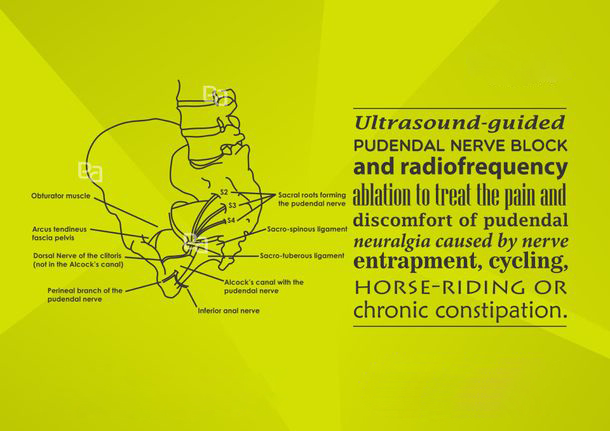

Treatments
ABDOMEN & PELVIC PAIN

Pudendal Nerve Block
Why do I need pudendal nerve block?
Pudendal nerve runs from your lower back, along your pelvic floor muscles, out to your perineum (the skin between your pubic bone and your tailbone). It supplies the skin between the anus and the clitoris (or penis) as well as the muscles of the urethra and the anus. The pudendal nerve is prone to damage either by compression or stretch. Common scenarios where this may occur include trauma, during cycling, prolonged, difficult or traumatic vaginal childbirth, or chronic straining during defecation caused by constipation. Pudendal nerve block can help in the diagnosis and treatment of chronic pelvic pain conditions such as vaginal pain, penile pain, scrotal pain, or perineal pain.
How is it performed?
A pudendal nerve block is a day care procedure and is performed with x-ray or ultrasound guidance to increase the accuracy and safety of this procedure. At Atlas Pain Care, Coimbatore, you will be asked to change to a hospital gown, and in the procedure room will be asked to lie on your stomach. Your lower back and buttocks will be cleaned with an antiseptic, and a sterile drape will be placed. A needle is directed toward the intended target area under x-ray or ultrasound guidance, and local anaesthetic will be administered close to the nerve
Pulsed-radiofrequency lesioning of the pudendal nerve
When the response to the block is good, but only lasts for a brief period, pulsed-radiofrequency lesioning of the pudendal nerve is offered. In this, the radiofrequency electric needle is introduced under ultrasound-guidance and is placed close to the nerve. The proximity to the nerve is then confirmed by passing tiny electric currents. Pulsed-radiofrequency is then performed. It is a daycare procedure that takes 30-45 minutes to perform. You will be discharged home on the same day.
What are the risks associated with this procedure?
This procedure is safe. However, with any procedure, there are risks, side effects and possibility of complications. The most common side effect is temporary pain at the injection site. Fortunately, serious side effects and complications are uncommon. Ultrasound to provide visualisation of the targeted structures significantly minimises risk.
Please read our FAQ section to know more about the do's and don'ts prior to and after the procedure.

